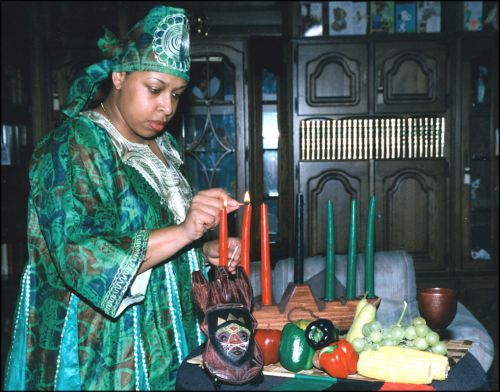Kwanzaa
Kwanzaa is a festivity held by the African Americans from the 26th of December until the 1st of January. It honours African roots, culture and unity. It was initiated in by Maulana Keranga (1941-). He is a famous professor of African stuides and an acitivist. Kwanzaa was first celebrated in 1966.
In its beginnings Kwanzaa was meant to be an alternative to Christmas. Nowadays many African Americans celebrate it together with Christmas and New Year. Kwanzaa is celebrated in both the United States and Canada. Kwanzaa holiday greeting is “Joyous Kawanzaa”.
Kwanzaa is based on seven principles or Nguzo Saba, as they are known. These principles are Umoja (Unity), Kujichagulia (Self-Determination), Ujima (Collective Work and Responsibility), Ujamaa (Cooperative Economics), Nia (Purpose), Kuumba (Creativity) and Imani (Faith). Nguzo Saba principles put together make Kawaida which is Swahili expression for tradition and reason.
 A woman lights kinara candles
A woman lights kinara candles
Like all festivities Kwanzaa has several symbols – crops, seven kinara candles placed in a special holder, common unity cup (Kikombe cha Umoja), gifts, a poster of the seven principles, and a black, red, and green flag. They are put on a mat.
Women celebrating Kwanzaa wear a traditional dress called kaftan or boubou. Children ceremonially show their respect for the family ancestors. During holiday homes are decorated with a piece of fabric called kente. Libation is shared from the Kikombe cha Umoja. There is often some music usually performed with drum. Reading of the African Pledge and the Principles of Blackness is also an important element of Kwanzaa festivities.